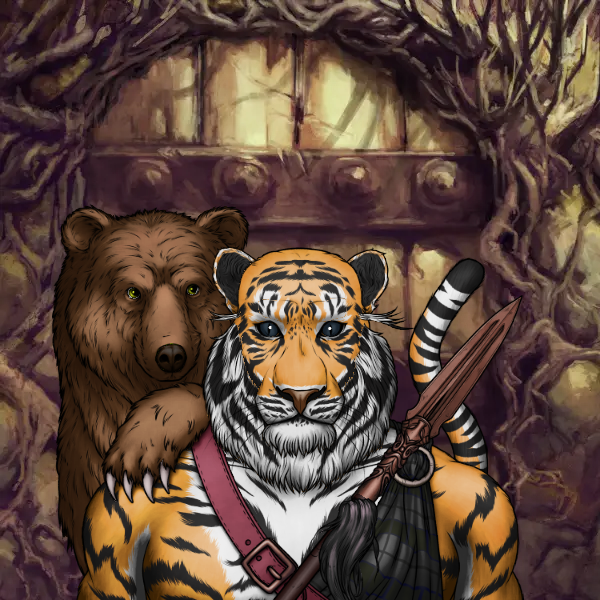Weretiger
Weretigers are shapeshifters and Literomancers who develop a totemic relationship with the spirit of the Great Tiger in its many guises.
Weretigers, strangely, have become associated with House Lapin. The two publicly known weretiger literomancers are both loyal Lapin supporters: James Woodwright, Captain of the Owsla, and Kindar, his uncle.
Basic Information
Anatomy
In human form, weretigers are indistinguishable from normal humans, though some possess features that reflect their animal side, such as a glassy stare, hair or beards with resemblance to a ruff or with light and dark striped patterns, a powerful build, or a languid, graceful way of moving. In tiger form, they are only distinguishable from normal tigers by their superior intellect. In either form, there is no scientific way to distinguish them from normal members of the species, as the therianthropic ability is totemic, not scientific.
Some weretigers, just like other werebeasts, can partially shapeshift, adapting elements of one form while in another form. For instance, a weretiger in tiger form might shift a paw to a hand or partial hand in order to manipulate objects, or a weretiger in human form might shapeshift only their eyes, to benefit from a great cat's night vision, or their fingernails to retractable claws for natural weaponry.
Totemically, all werebeasts can sense one another with their normal senses.
Genetics and Reproduction
Like most werecreatures, weretigers can choose to reproduce as a human or as the animal type they are. To do the latter requires that their partner also be a werebeast. Human babies are conceived and born in the normal human fashion, although it isn't uncommon for weretigers to conceive twins or even triplets, both identical and fraternal.
Growth Rate & Stages
If babies are birthed as cubs, at about three months old they usually shapeshift into a human toddler. Unless they, too, become totemically-connected literomancers, they maintain that form for the rest of their lives, developing from that point as a normal human child would.
Because becoming a shapeshifter is accomplished through a magical connection and not a genetic one, a literomancer might potentially develop into a weretiger at any time, as long as the totemic connection is strong.
Dietary Needs and Habits
Tigers are obligate carnivores, and weretigers tend to prefer a meat-rich diet as a result.
Behaviour
Weretigers often pick up some personality traits from their feline sides. They tend to be patient and watchful, seeing much and saying little. Some have a strong protective streak, while others are consummate predators, only doing what seems advantageous to them. Most are playful and affectionate when relaxed.
(singing) I am a tiger and I protect them all, diggy diggy hole, diggy diggy hole...
Additional Information
Social Structure
Tigers are solitary but social predators. Perhaps as a result, weretigers never seem to be present in numbers, but they always become a fixture of the social groups they are in. Although they can take the lead if need be, they are usually content to be a part of the pride, whatever form that pride might take.
Geographic Origin and Distribution
Weretigers almost certainly began in areas where tigers are common, and there have been references to them in ancient Chinese and Indian literature, but as knowledge of the world has expanded, the gregarious Tiger totem has expanded their influence, and seems willing to embrace people of all ethnic identities.
Perception and Sensory Capabilities
Weretigers, like all cats, can see extremely well in low light, due to the unique retro-reflector membrane behind their retinas, and the ability to lens their irises into slits, or dilate them completely. Their whiskers are tactile sensory organs that allow them to navigate even in total darkness. They are excellent visual hunters who can see at only one-sixth the light level required for human vision.
Tigers in cat form are too big to purr, so they chuff instead.
Civilization and Culture
Culture and Cultural Heritage
Tigers have been especially significant in Chinese, Indian, and Korean culture.
In Chinese folk tales, tigers kill evil men and protect good men. An able general is called a "tiger general" and an able soldier is called a "tiger warrior." They represent yang energy and are believed to ward off the three disasters: fire, thieves, and evil spirits. White Tiger is associated with the West and is a guardian of that direction. Tigers also guard tombs and the Five Elements, and their souls are said to descend into the earth to become amber when they die.
To the Koreans, the tiger guards tombs and is intrinsic to their national identity.
In India, people have both venerated and feared tigers for thousands of years. The goddess Durga rides a tiger when going forth to destroy evil. Tigers are associated with a number of Hindu deities and Buddhist myths, and often seemed to take a (deadly) disliking to invaders, such as Christian missionaries and Muslim conquerors.
This article is a work in progress, and may be subject to changes.
This article is part of a series related to streaming the Game of Tomes. For more information, see Streaming Game of Tomes.
Genetic Ancestor(s)
Scientific Name
Home belua tigris
Lifespan
Unknown. While it seems logical that weretigers would live as long as humans do, Asian legends speak of weretigers who turn white at 500 years and live up to a millennium.
Conservation Status
There are only two currently known weretigers in the world, although there are likely more hidden in areas that are not officially governed by Protectorates, such as India and Tibet.
Body Tint, Colouring and Marking
Weretigers may display either orange and white fur with distinctive triangular black-brown stripes, or white fur with similar stripes, in their tiger and half-tiger forms, and their eyes are usually ice blue or emerald green.
Geographic Distribution
Related Organizations
Related Ethnicities
Taste damascus steel, you undead bastards!








Comments